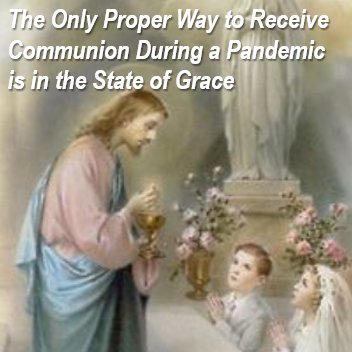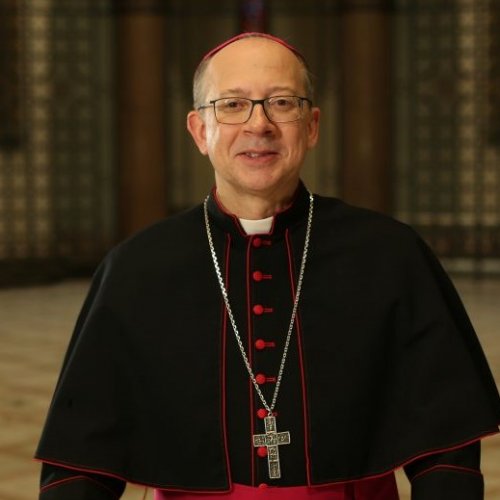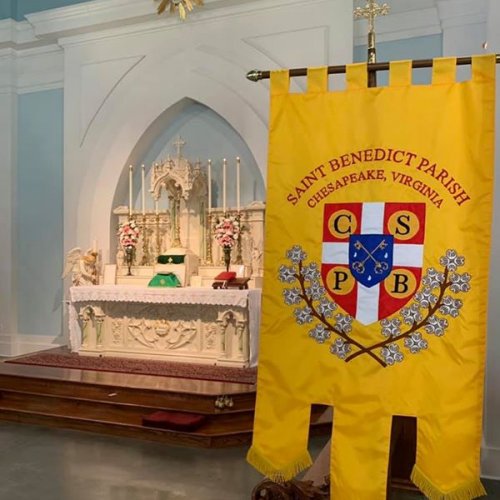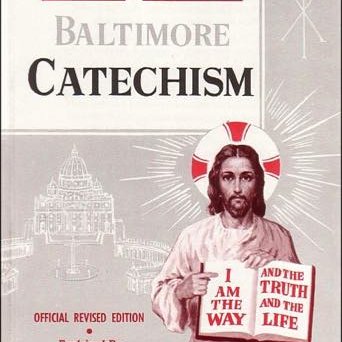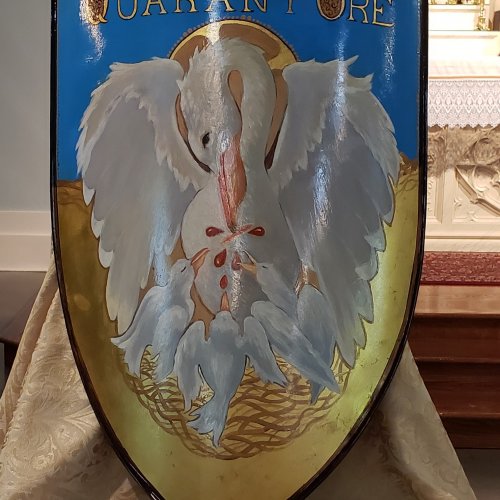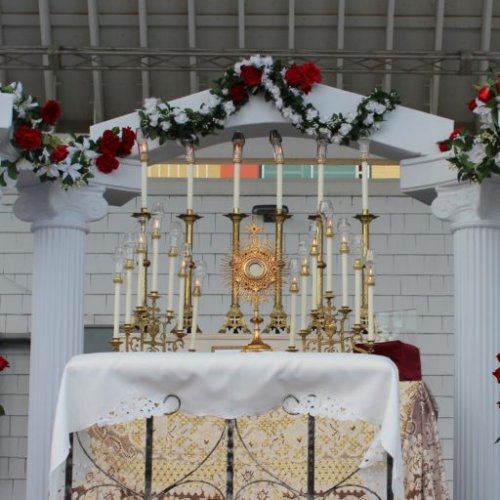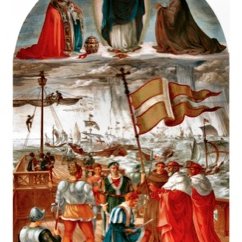Always Receive in State of Grace
St. Benedict’s Parish News
| Feast of St. Joseph March 19th - Masses at 8 AM (Low) & 7 PM (Solemn) NO 6 AM Mass Feast of St. Benedict March 21st - Masses at 6 AM (Low) & 8 AM (Solemn) |
Past News Feeds
Bishop Knestout will be here Wednesday morning. He will attend the 8 a.m. Mass in Choir --
(in Choir means attending in the Sanctuary, not offering the Mass at the Altar). This is his first visit since his installation on January 12, 2018. He will meet with the Parish Staff on Wednesday morning following the Mass.St. Benedict's Parish unveiled and blessed its coat of arms. The Parish's Processional Banner is pictured here.
The Crest is based on the St. Benedict Medal with the White Cross and letters from the Medal standing for: "Crux Sancti Patris Benedicti" or "The Cross of [our] Holy Father Benedict". In the center is the crest of the Priestly Fraternity of St. Peter (http://www.fssp.com), the priests that staff our parish. On the Parish Banner, are added the flowering Dogwood Branches, Virginia's state flower. Also, of note is the legend of the Dogwood, and its role in the Crucifixion of our Most Blessed Lord: "Prior to Christ’s Crucifixion, there was one tree, the Dogwood, that rose higher than any other hardwood tree. It was a tall, straight, and majestic tree, and in constant demand. Accordingly, it was the wood selected for Christ’s Cross.
According to legend, the Dogwood felt such sorrow over this task , as the vehicle for Christ’s agonizing Death, that it asked our Blessed Lord to never again be charged with such a task. Answering this request, Our Lord, from then on, made the Dogwood a smaller, more bush-like tree with twisted limbs.
Also, from then on, He made it to burst forth in full bloom annually, to announce His majestic Resurrection at each Easter. He also gave the Dogwood the marks of the Crucifixion in its bloom. Its four large petals represent the cross he died upon, and each petal displays four red-tinged notches that are said to represent four nail holes. And in the center of each flower is a green cluster that is symbolic of Jesus’ crown of thorns." Also, presented this day, were beautiful plaques of our Bishop's Crest, and our Parish Crest that will now hang over each side entrance door to our Church.St. Bendict’s Catechism classes begin Sunday at 8:45 to 9:30 a.m.
The Catechism Catalog including revised requirements and Class schedule is posted on the parish website for your review at: http://www.stbenedictsparish.org/catechism/
If parents were unable to make our parent-teacher meetings on the last two Sundays, and have not already arranged a makeup meeting with Father, please do so as soon as possible.40 Hours Devotion occurred Thurs thru Sat (20-22 Jun) and was followed Sunday with the External Solemnity of the Feast of Corpus Christi . The Shield was displayed outside the Church during this devotion, and will be displayed in similar manner during future 40 hour devotions.
Pictured above is a shield, a Eucharistic Shield denoting the Forty Hours Devotion. In fact, not in Latin, but in Italian, the Quarant 'Ore is more commonly known actually, than the Latin. And, the reason that we have this, is that when a Church has Quarant 'Ore, it should have some sort of sign, denoting to people that the devotion is occurring, because this is a huge devotion in the life of the Parish. This is a chance for us to come and proclaim our faith in our Eucharistic King, to show our gratitude to God for all that He has done for us, and to show our love for Him who does so much for us. So, this will be on display, whenever we do this devotion, so that people will know that 40 Hours Devotion is taking place.
This actual Shield was a gift from the parishioners, purchased as part of "Father's Lenten Wish List", and now part of the patrimony of St. Benedict's. That will hopefully, give honor and glory to God for generations to come. The symbol is of the Pelican impaling itself, and feeding its young, which it is known to do apparently, in nature. Also, it has always been a symbol of the Eucharistic Christ, where Christ feeds us, does He not, with His Own Flesh and Blood. So, this is a great symbol, indeed. This was on display outside the Church during our recent 40 Hours Devotion, that began on Thursday, 20 Jun at 6:30 p.m. and ran until Noon on Saturday, 22 Jun. It was followed, on Sunday 23 Jun, with our External Solemnity of the Feast of Corpus Christi. This shield will also be on display outside the Church during future 40 hour devotions.A great crowd was walking down the boardwalk of the beach, the line of people creating a mighty river that stretched far down the shore. At their head an icon of St. Michael was carried aloft, followed by the main banner and the processional crucifix. Then came a stately row of flags representing the United States, the Vatican, POWs/MIAs and the State of Virginia. The men in colorful capes who bore the flags also carried their own flag, which, of course, was that of the Knights of Columbus.
Beyond them came the clerics in attendance, and then four scarlet-caped Knights carrying a gold-fringed canopy. Under the canopy was Our Eucharistic Lord, enthroned in a magnificent monstrance held by the hands of a priest in a white cope with IHS emblazoned on the back. And then followed another row of Knights, and with them the vast crowd of faithful who had come to walk with Our Lord in the annual Eucharistic Procession on the Virginia Beach Boardwalk.
The event, which is a coordinated effort of several parishes, began at Star of the Sea Catholic Church, where the faithful first gathered and Our Lord was enthroned in the monstrance before the procession exited the church, crossed over Pacific and Atlantic Avenues and turned north onto the broad boardwalk that parallels the beach. One can only imagine how the waves of the neighboring sea sang along with the hymns the people sang, and how the incense offered to Our Eucharistic Lord mingled with the salty maritime air. He Who made the mighty oceans was receiving the praises of His own creation, and He passed by under the appearance of that most humble creation, a little piece of bread.
The procession then entered a park where an altar of repose had been arranged. Our Lord was placed upon the altar, and there was a period of silent adoration and a short sermon on the Eucharist followed by Benediction. Then all returned to Star of the Sea, following the same route they had come.
This is the sixth year for the procession, although there have only been five that have taken place, last year’s being cancelled due to Hurricane Matthew. The inaugural event took place on October 13, 2012, the 95th anniversary of the Miracle of the Sun, and this year’s was held near the 100th anniversary. The procession is the fruit of an idea planted nearly forty years ago when founder Michael Cistola was still a student at Star of the Sea school. The school was staffed by IHM sisters, and one of them expressed her dream of a procession on the Virginia Beach Boardwalk honoring Our Eucharistic Lord.
The sister’s idea stayed with Mr. Cistola, and the time came for its materialization in 2012. In response to the HHS mandate which was being put forward at the time, His Excellency the Most Reverend Francis DiLorenzo, the late Bishop of Richmond, published bulletin inserts discussing the U.S. Bishops’ united opposition to the mandate and the Bishops’ call to all Catholics to urgent action and prayer against the unjust law. Mr. Cistola, a parishioner at St. Benedict’s, the FSSP’s parish in Chesapeake, saw the procession as a response to this call, and subsequently asked and obtained the Bishop’s permission to hold the procession. Fr. Neal Nichols, pastor of St. Benedict’s, coordinated the liturgical aspects of the procession and has done so every year since, meeting at Star of the Sea with the planning committee several times a year and involving as many clergy as possible. St. Benedict’s always has a grand representation at the procession and among the volunteers who organize the event.
If you are in the Virginia Beach area in October, do consider joining the Eucharistic Procession on the Virginia Beach Boardwalk. An idea sown in the mind of a child by a devoted IHM sister so many years ago has blossomed into a thing of celestial beauty, that, Deo volente, will grace the shores of Virginia Beach for years and years to come.Terrible as an Army Set in Array
On October 7, 1571, one of the most decisive and astonishing naval engagements in history unfolded in the Gulf of Patras, near Lepanto, in what is now Greece.
Selim II was Sultan of the mighty Ottoman Empire and successor to the famous Suleiman, who had declared that he would wage jihad by land and sea until all Europe lay under the banner of Islam. Politically divided, the leaders of Europe had done little to stop the Turkish advance. Christendom had been torn by the Lutheran revolt, and Catholic nations had no armies to spare.
These developments in Europe had not escaped Selim’s notice. The island of Cyprus was a strategically important possession of the powerful city-state of Venice. Seeking to annex Cyprus as the next step in Turkish domination of the eastern Mediterranean, Selim demanded that Venice cede Cyprus or face war. Venice chose war.
Pope St. Pius V correctly discerned that if the Turks were not stopped now, every port in Europe was in danger of brutal attack. He entrusted the Venetian cause to the Blessed Virgin Mary and called on all Christians to pray the rosary. Through painstaking efforts, he formed a Catholic alliance, the Holy League, with Don Juan of Austria in command. Don Juan had a strong devotion to the Blessed Virgin; he permitted neither blasphemy nor immorality aboard his ships. On taking up his commission, Don Juan and his men fasted for three days.
Fulfilling their threats, the Turks landed on Cyprus in force, and besieged and captured first Nicosia and then Famagusta under its dauntless commander, Bragadino. They destroyed both cities, slaughtered many civilians, and dispatched men, women, and children to the slave markets of Istanbul. Finally, they murdered Bragadino with horrific cruelty.
The Holy League’s fleet assembled in response. On September 16, 1571, the papal nuncio blessed each warship as the Christian fleet sailed from Messina, each crewman with a rosary in hand. With battle imminent, the Pope ordered the churches of Rome opened day and night for public recitation of the rosary. The Christian fleet was significantly outnumbered as it sailed to the Gulf of Patras, but in the early morning hours of October 7, the wind abruptly shifted in its favor. The Turkish admiral raised the green banner of Islam while on Christian vessels, priests heard confessions and offered the Holy Sacrifice of the Mass.
With the Turkish galleys in their trademark crescent formation, battle was joined. Cannon roared and archers spat clouds of arrows that spattered the decks like deadly rain. The battle raged on while across Italy, wave upon wave of fervent entreaty soared to Heaven: “Hail Mary…Hail Mary… pray for us…pray for us…pray for us.”
Soon the Turkish line began to disintegrate. Christian galley slaves broke free and joined the fight. Aboard the Turkish flagship, the green banner was down, the admiral decapitated, and Don Juan’s banner, blue as Our Lady’s cloak, was flying. By midafternoon, the Turks had lost 167 ships and 8,000 men, with 10,000 captured. The Christians lost only 12 ships and suffered 7,500 casualties. Though the Ottomans had held on to Cyprus, their advance was checked and their naval domination of the eastern Mediterranean was effectively over.
In Rome, the cardinals conferring with Pius V suddenly became aware they had lost the Holy Father’s attention. The pope was gazing through an open window, awestruck, at a vision no one else could see. He said, “Let us set aside business and fall on our knees in thanksgiving to God, for He has given our fleet a great victory.” He wept when the official reports arrived. Church bells rang across Europe in both Catholic and Protestant lands; all Christians knew the import of the pivotal battle. The Pope ordered a Mass of thanksgiving and later declared October 7 a feast day, Our Lady of Victory, known today as Our Lady of the Rosary.
“Who is she that cometh forth as the morning rising, fair as the moon, bright as the sun, terrible as an army set in array?” Cant. 6:10 (D-R)

